Symbiotic Bacteria Protect Beetle Larvae From Pathogens
Bacteria produce antifungal compound protecting the eggs, larvae, and pupae from infections / Bacterial community is retained even during molting stages.
Bacteria produce antifungal compound protecting the eggs, larvae, and pupae from infections / Bacterial community is retained even during molting stages.
Lagria beetles have developed unusual physical traits to protect their progeny: Small invaginations on the backs of the larvae are inhabited by defensive bacteria. As shown in a new study, the symbiotic bacteria protect the beetles from pathogenic fungi during their development and also during the molting phase when they are particularly vulnerable.

Adult Lagria villosa sitting on top of a soybean plant
© Rebekka Janke
"The Lagria beetles have found a way to prevent harmful fungal infections and ensure the survival of their offspring," said Rebekka Janke of Johannes Gutenberg University Mainz (JGU). As part of her doctoral dissertation research she examined the interplay of symbionts and beetles under the supervision of Laura Flórez, who now works as a researcher at the University of Copenhagen, and Martin Kaltenpoth, director at the Max Planck Institute for Chemical Ecology and head of the Department of Insect Symbiosis. Cooperating partners in Jena and Brazil were also involved in the research work.
Burkholderia gladioli colonizes pockets on the back of the Lagria larvae
For invertebrates such as beetles, the cuticle, the hard chitin armor with a thin, water repellant cover, is the first and most important line of defense against predators and pathogens. However, it can also serve as a habitat for microbial symbionts. Researchers had discovered already in the early 20th century that larvae of Lagria hirta had three small pockets on their backs filled with bacteria. About 100 years later, Martin Kaltenpoth and Laura Flórez showed that females of the species Lagria villosa squeeze out the symbiotic bacteria while laying eggs. These bacteria protect their eggs from fungal infections on the moist ground. Eggs without this defense provided by the bacteria Burkholderia gladioli were overrun by mold fungi.

Lagria villosa larvae foraging in the soil and leaf litter
© Rebekka Janke
In their latest work, the research team shows that the bacterial symbionts of Lagria villosa inhabit the invaginations on the backs of the insects during the entire larval development and that these small pockets remain open to the outside via a narrow channel. In addition, the pockets are not shed during the molting of the larvae, but remain intact throughout larval development. "During molting, some of the symbionts are released on the surface of the larvae, where they provide protection from fungal infection in this critical phase", added Martin Kaltenpoth.
Lagria villosa are Lagriinae beetles that originated in Africa and have been proliferating in South America since their introduction in the 1970s. They complete seven larval stages with corresponding molting stages before they pupate and subsequently emerge from the pupa as an adult insect.
Burkholderia strain Lv-StB and antifungal compound lagriamide verified
For further investigations, Rebekka Janke collected samples from all life stages of the beetles from fields in Brazil for in-depth analysis together with her research colleagues. The findings revealed that the symbiont strain Lv-StB of Burkholderia gladioli, which is vital for protection during the egg stage, is also the main defender of the subsequent developmental stages. The Burkholderia strain produces an antifungal compound called lagriamide, which is found in all stages, i.e., on the surface of the eggs, larvae, pupae, and also on the inside of the molted cuticles. Another investigation revealed that the symbionts were present during the larval stages both genders, male and female. During pupation, females retain the symbionts for transmission on to the next generation while the titers decline in males.
"The removal of these bacterial helpers significantly impairs the survival probability of the young larvae as soon as they are exposed to pathogenic fungi", stated Laura Flórez. Even though the molting process can contribute to the removal of damaging intruders from the cuticle of the insects, during this time the larva is also robbed of its protective layer and is thus more susceptible to infection. "The Lagria beetles have found a way to circumvent the problem by creating pockets in the protective casing on their back, which remain intact even through repeated molting events," explained Flórez.
Publication: Rebekka S. Janke, et al., Bacterial ectosymbionts in cuticular organs chemically protect a beetle during molting stages, The ISME Journal (2022). DOI: 10.1038/s41396-022-01311-x.
Original Story Source: Max Planck Institute for Chemical Ecology

 Alerts Sign-up
Alerts Sign-up